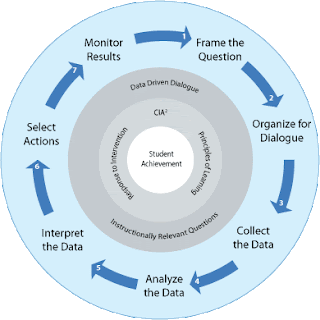Students and their achievement are at the center of everything teachers do. Assessment data is extremely valuable in being effective educators. Teachers can use both formal and informal assessment data in order to examine student performance. Using web 2.0 tools such as Google Sheets or Zoho, teachers can organize and analyze student data in order to individualize learning and develop new learning targets for their students. By sorting the data, teachers can make decisions about instructional groupings and teaching methods based upon common student performance.
 |
Once the data was entered into the spreadsheet, I color-coded it using conditional formatting to designate correct vs. incorrect answers. With this information, I was able to identify how many students met the tested standard for each question. This allowed the teacher, not only to see which students needed certain skills and concepts revisited, and which students were struggling to master the concepts overall, but also to reflect upon their teaching practices and inform future instruction, especially when a large percentage of the students failed to master a particular standard. Furthermore, beyond this single test, the teacher now has a foundation for including other measures of student performance and recording more data to analyze student growth.
In looking at the sample class data, there were about three questions in which more than half the class did not meet the standard. These concepts should be retaught in a whole class setting with purposeful scaffolding of the skills and concepts. During some class activities surrounding these standards, noting which students demonstrated a solid grasp of the standard and which students struggled could help with pairing students together to provide additional in-class support.
I decided to also sort the student data by overall percentage correct to help identify which students need the most intensive support. This bottom tier has the most gaps to fill; there are potentially foundational gaps that impede the students' ability to master the current grade level standards. Therefore, the teacher should administer other assessments for these students to pinpoint the areas of greatest need. At the same time, stronger students can be enriched; they can delve deeper into the standards they understand through projects involving higher-order thinking skills.
Using Google Sheets, this data can be shared with colleagues and administrators to observe trends and collaborate to make decisions about possible next steps for instruction. Teachers can use classroom performance and assessments as indicators of student growth, as well as include standardized assessment data. For example, my school uses NWEA Measures of Academic Progress test three times a year to track student progress. I use Google Docs to analyze my students' performance in the various strands as well as document their progress toward their spring score goal. I create instructional skill groups based on the data and ensure that my students are getting the interventions that they need.
Overall, data is not something that teachers should shy away from. Rather, it is something that should be considered and analyzed daily, and shared in a collaborative environment, in order to improve teaching practices and become more effective practitioners.
Open Data Assessment Sheet in Google Sheets
References:
Logan, L. (2015). 5 Ways to Use Data to Improve Your Teaching. Retrieved from http://www.amplify.com/viewpoints/5-ways-to-use-data-to-improve-your-teaching
Img Source: http://www.dallasisd.org/cms/lib/TX01001475/Centricity/Domain/5173/Data-Analysis-Model_Complete_v5.gif

Jeni, you make many great points in your post, thanks for sharing! I agree, data assessment can be very helpful in the classroom, but some teachers may not feel comfortable assessing data or even know how to set something like this up. I also used Google Sheets and found them very helpful. By setting something up like this for one teacher can be shared and used for other teachers as well, that is one advantage of using Google Sheets, they can easily be shared among others. Also, I haven't heard of Super Quiz or Flubaroo before, I'll have to check them out! That's another great addition to Google Sheets since they can be used as add-ons.
ReplyDeleteI also took a look at your Google Sheet you created for your Data Assessment, it looks very similar to mine. However, I tried to use as many formulas as I could so less manual steps needed to be taken. Check it out (https://docs.google.com/spreadsheets/d/11s_9trF4owQqLpg30XxE3z5QTsqVtxTGnP4XJXKorjM/edit?usp=sharing), I ended up figuring out how to create formulas for percentage of answers correct as well as coloring the cells with conditional formatting based on the value of a cell. So I created an row with the correct answers and created my formulas based off of these values. It made it a lot easier to format everything once I setup these formulas.
Thanks for your ideas about the formulas! I did set up conditional formatting for correct vs. incorrect answers. I liked your countif formula to help with calculating the percentages as well.
DeleteJeni - Your table looks good. There is a lot of information that can be drawn from it. I liked that you sorted the students and questions so the you could see the progression of what was not scoring highly to what was scoring highly. This allows teachers to see where to start easily and quickly. I did not think to do that with mine. Like me you left the answers in the table which I liked so that I could see if there was a common misconception with a certain question. In some cases we as teachers need to understand that it was not a student misunderstanding but sometimes it is the question and the wording that could be the issue. I try at all times to take the assessments I give my students so that I can say with certainty that the questions are asking what I would like them to.
ReplyDelete